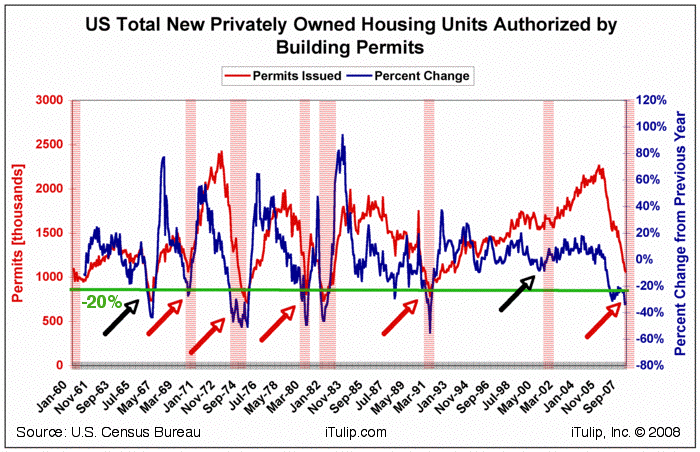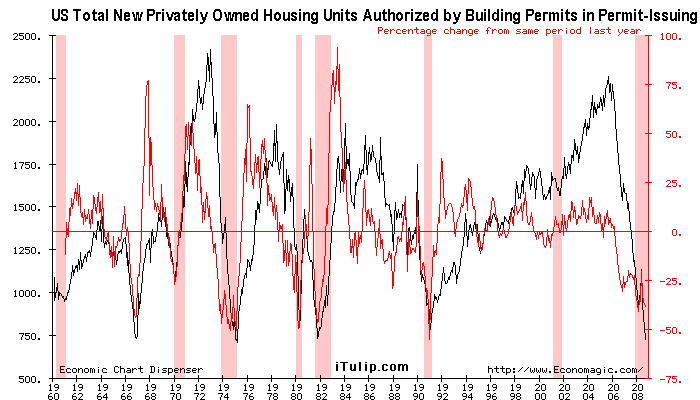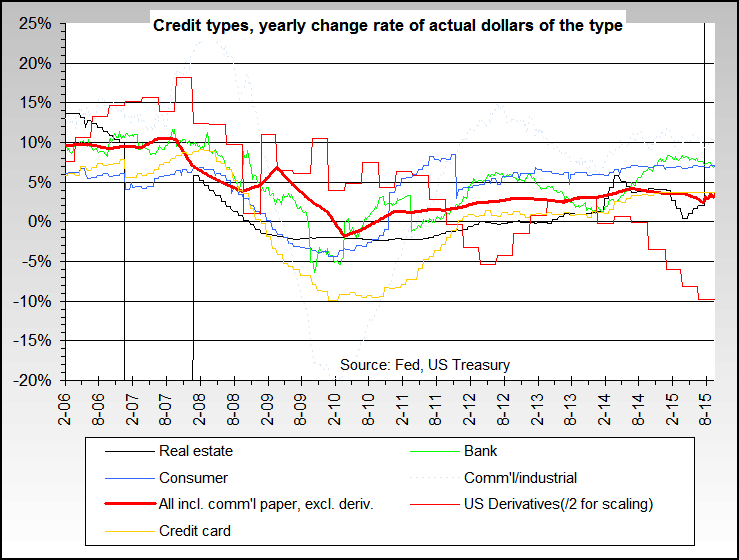 |
Monday the Business Cycle Dating Committee of the National Bureau of Economic Research (NBER) turned its keen analytical eye on the rear view mirror of the US economy and spotted a year off in the past the start of the recession in Q4 2007 that we spotted through the windshield a year before in October 2006 (see Recession Q4 2007). What did we know that they didn't?
by Eric Janszen
Over the past few days we've received a pile of email from readers asking, how did you guys do it again? Do you have a time machine? Do you use astrology? Do you see the future as visions after swallowing a fist full of mushrooms with a pint of tequila? Not at all. You can forecast the economy, too, by following these four simple steps.
Step 1: Reject false premises. The major premise to rid yourself of is that you have to be some kind of analytical genius or mystic with a crystal ball to forecast the US economy. We have heard this over and over again, yet somehow since 1998 we have forecast two recessions and numerous stock market turning points accurately.
I wonder, is there a class that all business reporters and editors attend where they are taught to say, “You cannot forecast the economy. No one has a crystal ball” because I hear that exact phrase repeatedly, as if the economy is as inscrutable and mysterious as the Bermuda Triangle, its future as random as a winning lottery ticket and anyone purporting to be able to tell it is no more credible than an astrologist.
The truth is that in macroeconomics, as in many things in life, effects often follow from causes, and events logically from antecedents. The trick is to understand the antecedents and processes involved.
For example, if a household earns $4,000 a month from two incomes, borrows $1,000 a month, spends $5,000 a month, has $2,000 in liquid savings, then suddenly loses access to half the $1,000 in monthly credit, how many months will pass before the household runs out of money if it does not reduce spending or sell jewelry or other property to raise cash? (Answer: Four months.) How about if it loses access to both the total $1,000 of monthly credit and one of the two $2,000 monthly incomes? ? (Answer: Less than a month.) This is not rocket science. Now apply this equation to the 75% of US households that live this way -- without savings because they believed that home and stock price inflation was doing the saving for them and that a fresh source of credit will always be available once the last one dries up -- such as another cash-out refi boom. Now assume that millions of households in this bind in fact cut spending so that they can last longer than a few months, how much does that reduction in spending across all of those millions of households reduce the incomes of other households? Now estimate the timing of the inevitable crash of both housing and stock prices that must happen sooner or later to put all of these households into this hole and -- presto! You too have a “magic” crystal ball. But first you have to admit that these are the facts and that if you use them you can follow them to a logical conclusion.
Step 2: Do not listen to FIRE Economy economists. These are the economists who worked for the extended Wall Street financial products sales and marketing department also known as the Wall Street Journal, Barron’s, New York Times Business, CNBC, and FOX Business News, to name a few, at the time we made these forecasts. They have since reformed considerably, but back in the day when we were making our forecasts the consensus view was, expressed between ads for mutual funds and cash-out refinancings: “Nine out of ten credentialed, professional economists say, there is no housing bubble!” Following from that fallacy, naturally the consensus economists saw no chance of a recession after the collapse of the housing bubble that they claimed didn’t exist. According to the economists who appeared in the media frequently this past year, the housing market and stock market bubbles did go bust -- and of course they knew it was coming all along -- and of course it has bottomed. At last count, according to these guys, housing and stocks have bottomed at least fives times so far this year. Not coincidentally these optimistic economists often work for industry groups, such as the National Association of Realtors. Not that there's anything wrong with that.
If you made a forecast in 2006 that the housing market was going to crash and bring down the economy, you were viewed as outlandishly bearish and not credible. If you suggested then that venerable Wall Street investment banks were going to fail as a result of what we called Credit Risk Pollution, you were a complete nut. If you suggested that GSEs Fannie Mae and Freddie Mac had nationalization in their future, you were handed a tin foil hat. Why? You were not selling product: stocks and mortgages. Bad economist.
Who advertised on these shows and in these publications? Brokerages selling the dream of quick riches made by buying and selling stocks, investment banks pitching wealth management services with a heavy dose of stock mutual fund buy-and-hold religion, and mortgage companies hawking home loans on the premise that housing prices only rise and lead to inevitable wealth creation.
What a racket.
Step 3: Do your own primary research and analysis. The US government has its problems but lack of data on the economy is not one of them. The Bureau of Labor Statistics, Census Bureau, and the Federal Reserve are but three of many excellent resources.
Start from the bottom and work your way up, by industry, age group, state. Ask basic questions: Which industries are generating jobs and income? Where? How sustainable is the demand for the products and services that those industries produce or deliver after the Rube Goldberg credit system keels over?


Chart created Dec. 3, 2008 from Economagic.com from BLS data
As of December 2, 2008, it’s official: the recession started in December 2007. Now the BLS data automatically include the recession information so the graphing software fills in the pink shading to indicate recession for us, as in the chart above. Thanks, fellas!
In retrospect, the forecast appears obvious. By combining various indicators, such as duration of unemployment, durable goods purchases, housing permits, and housing prices, and comparing these to historical trends, the start of the recession could be forecast a year in advance and confirmed after the start. Do your own independent research and analysis and you will come to the same conclusion.
Step 4: Stress test your theories. Develop a 10,000 plus member community of smart business people from all over the USA and globe and listen to them as they respond to your analysis and describe what they are seeing. We cannot always be correct right out of the chute, so an army of bright people correcting our errors helps us refine our theories. Trip reports over a period of years are especially helpful because they give a perspective on how economic conditions are changing.
Future Forcasts
Next you’ll hear FIRE Economy economists say, “We are in the worst recession since 1982” as if they’d been forecasting the recession all along and earned the right to continue to make forecasts. Then they will claim, “Like 1982, the recession will last about a year. We are through the worst of it.”
When you hear this prognosis note that it ignores the obvious fact that the 1980 to 1983 recessions were induced by the Fed on purpose by raising short-term rates a full 8% over the rate of inflation to 1) chase money out of hard assets and back into financial assets, launching the FIRE Economy in the process, and 2) create high enough unemployment to break the unions and maintain competitive low wage rates. Does any serious economist believe that the current now year old recession was induced by the Fed intentionally to manage inflation down? This is the real thing, a recession that the Fed didn't start. When is the last time that happened? That's right, in the 1930s.
Short rates are 1% yet the economy’s collapse, as measured in rising unemployment and declining output, is picking up speed. Since the early 1980s the US public and private sectors have borrowed their way out of recession and back to “recovery.” Each time the level of debt grew higher, from a dollar of new debt per dollar of GDP growth, to two, to three, to four, to five. Each time the US went into recession it dragged the world into recession with it, and each time US trade partners and political allies took turns bailing the US out to in turn pull them back out of recession with the great American demand engine.
It isn’t working this time. Major foreign private and official creditors to the US, especially the UK, China and Japan, are struggling with recessions. The US cannot pull them out of them because this time the domestic, credit-based US demand engine is broken.
We are in the first year of a multi-year debt deflation and transformational depression. Anyone who tells you otherwise does not understand the antecedents and processes driving the decline. Their forecasts will be incorrect.
The good news is that out of this the US economy may develop into a more honest, fair, and sustainable form based on saving and investment rather than borrowing and consumption. The bad news is that politics can just as easily take the economy the other way, with debtors pitted against creditors and the poor against the rich, with an Argentina Lite outcome. Watch debate over the US auto company and financial bailouts and you can already see the battle lines forming. For a country that has for hundreds of years depended on entrepreneurs and invention to drive the nation and economy forward, the signs are ominous. All the money to date has gone to large financial institutions and businesses. If we’re going to do that we also need to cut the income and capital gains tax rate for small businesses and private equity to zero to level the competitive playing field or we’re sunk.
When will the recession end that started a year ago? That will depend on the political response to the private sector debt problem. All the infrastructure programs in the world won't make it go away, and as long as it persists we're driving with the brakes on.
Here’s a thread where we are sharing notes on how the recession is affecting our members' employers, including comments from a bunch of members who are employers.
First person experiences and critique will continue to inform our data-driven analysis. We'll let you know when we think the real bottom is in and you can count on the NBER to let you know a year later.
As a final note, I can't help sharing this video sent to me by one of our friends. The economy may be going to hell in hand basket, but we refuse to give up our sense of humor in the holiday spirit.
Note: We have re-opened the Contest: Most Accurate Forecast of the Now Official Current Recession since January. Good luck!
iTulip Select: The Investment Thesis for the Next Cycle™
__________________________________________________
To receive the iTulip Newsletter or iTulip Alerts, Join our FREE Email Mailing List
Copyright © iTulip, Inc. 1998 - 2007 All Rights Reserved
All information provided "as is" for informational purposes only, not intended for trading purposes or advice. Nothing appearing on this website should be considered a recommendation to buy or to sell any security or related financial instrument. iTulip, Inc. is not liable for any informational errors, incompleteness, or delays, or for any actions taken in reliance on information contained herein. Full Disclaimer

 Katherine McIntosh holds the photograph taken with her mother in 1936.
Katherine McIntosh holds the photograph taken with her mother in 1936. 
 Watch "we would go home and cry" »
Watch "we would go home and cry" »

Comment